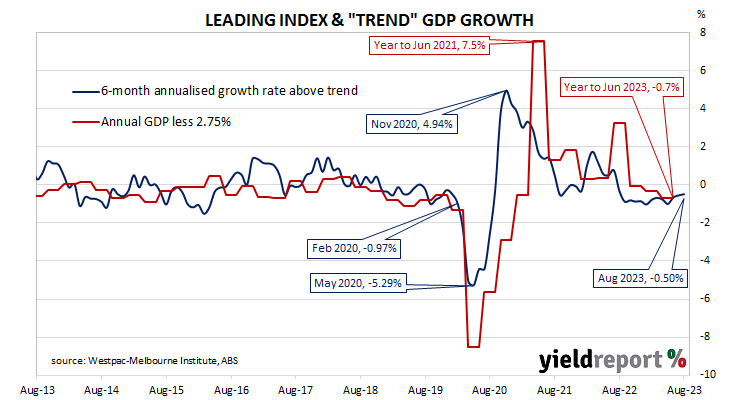Summary: Leading index growth rate rises in August; extended period of weakness continues; reading implies annual GDP growth of around 2.20%; ACGB yields rise moderately; rate-rise expectations firm; Westpac: less than 1% GDP growth expected for year to June 2024.
Westpac and the Melbourne Institute describe their Leading Index as a composite measure which attempts to estimate the likely pace of Australian economic growth in the short-term. After reaching a peak in early 2018, the index trended lower through 2018 and 2019 before plunging to recessionary levels in the second quarter of 2020. Subsequent readings spiked towards the end of 2020 but then trended lower through 2021, 2022 and the first half of 2023.
The August reading of the six month annualised growth rate of the indicator registered -0.50%, up from July’s revised figure of -0.56%.
“The economy continues to move through an extended period of weakness,” said Westpac Chie Economist Bill Evans. “Despite another slight improvement this month, the Leading Index growth rate continues to track in negative territory, the measure having now been below zero for just over a year.”
Index figures represent rates relative to “trend” GDP growth, which is generally thought to be around 2.75% per annum in Australia. The index is said to lead GDP by “three to nine months into the future” but the highest correlation between the index and actual GDP figures occurs with a three-month lead. The current reading is thus indicative of an annual GDP growth rate of around 2.20% in the next quarter.
Domestic Treasury bond yields rose moderately on the day, broadly in line with the rises of US Treasury bonds yields overnight. By the close of business, the 3-year ACGB yield had gained 6bps to 3.93%, the 10-year yield had added 5bps to 4.23% while the 20-year yield finished 4bps higher at 4.54%.
In the cash futures market, expectations regarding further rate rises firmed. At the end of the day, contracts implied the cash rate would change little from the current rate of 4.07% in the short term and average 4.085% through October, 4.145% in November and 4.20% in December. February 2024 contracts implied a 4.24% average cash rate and May 2024 contracts implied 4.27%, 20bps more than the current rate.
“Westpac expects this weak performance to continue over the next year or so with growth expected to come in at less than 1% for the year to June 2024,” added Evans. “There may be some upside risks to that downbeat number now that population growth is likely to exceed 2% in 2023.”


